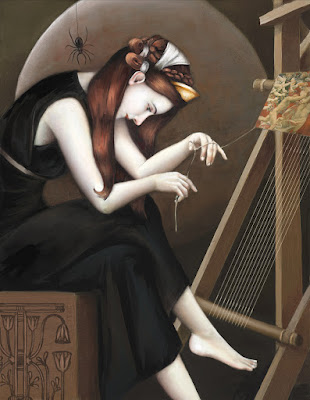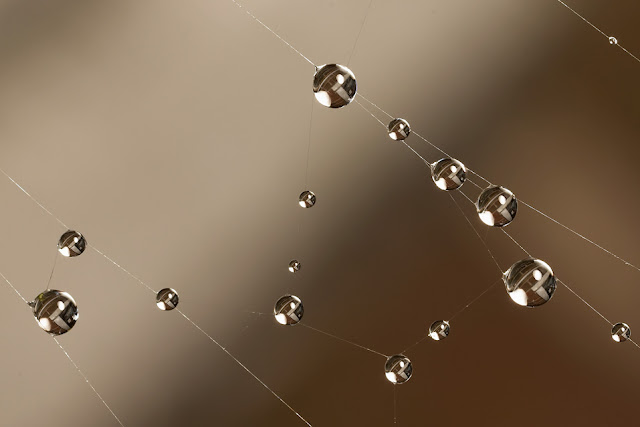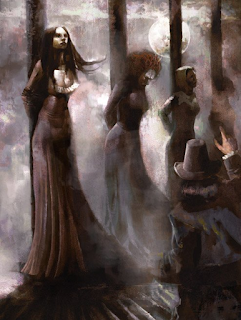Lady bug, lady bug, fly away home. Your house is on fire, your children will burn.

In 2016, we witnessed an epic confrontation between the Humans and The Machine, a battle for the Earth itself. The epicenter was at Standing Rock, North Dakota. We saw the Humans, armed only with consciousness, with prayer, songs, and reverence, honoring their ancestors by standing against the Machine to protect our most delicate, endangered, and precious element - water.
 |
| N.C. Wyeth |
Without living water uncontaminated by pollutants, nothing else CAN live. Essentially, if we do not secure our water, we are committing genocide on our own forthcoming generations.
From all corners of the world, the Humans heard this call and responded with support for the Water Protectors. Like lost relatives, people poured in from the Four Directions to express the awareness that has organically grown within so many of us, that our most urgent mission is to save our planet. Water is the bottom line. The need to protect the water arises from its undeniable, irrevocable foundation of our life here.
 |
photo taken during 2010 pilgrimage to India
with Beads on One String
|
The responsibility to care for the Earth is a deeply felt obligation within the traditional ways of indigenous people. Thank god that regardless of all we have done to annihilate them, they are still here. Thank you, 'ignorant savages', for enduring beyond our ignorance and outsmarting us for 500 years. Oh, excuse me, I had the "ignorant savages" part backwards --- that was
us, the newcomers, the colonists, dedicated to religious freedom - except yours, which we outlawed.
The 7th Generation foretold in the days of Black Elk and Sitting Bull has arrived, and they - the youth - are leading the charge, adhering to the principles of civil disobedience as demonstrated by Dr. King and Ghandi. Non-violent, grounded in prayer and ceremony, they have the authority to lead this charge against the Machine; no one can question the authenticity of their position.
 |
| Black Elk |
At the dangerous intersection where we now find ourselves, we begin to listen, to SEE them; in their pure intention, we recognize something ancient and beautiful in ourselves, a fundamental unity shared by all the Humans, which is great love for the beauty and generosity of our sparkling planet.
Earth has always been thought of, metaphorically, as Feminine. By the Humans, she is spoken of, with great affection, as Our
Mother. The treatment of women (our mothers and grandmothers) over the last few centuries has mirrored the prevailing perception of Earth as a resource to be dominated and exploited, with little regard.
The Earth is responding, in Her own language. The vocabulary of floods, droughts, fires, ice storms, dust storms, toxic algal blooms, species extinctions, tornadoes, volcanoes and earthquakes, are communicating to us the Earth's distress.
Since 2005, the International Council of 13 Indigenous Grandmothers have traveled the world conducting ceremonies for the safety of our water, and speaking for the relatives who have no voice (or at least, they don't speak English; they speak bird chatter, fish talk, and the language of the trees); or whose voice cannot be heard by those whose hearts have disconnected from the Earth, those to whom the Earth is not a living being, but merely a repository of materials for us to burn through and discard, creating a level of pollution unsurpassed in its wastefulness and toxicity.
 |
| Winona LaDuke of Honor the Earth |
It is critical that we continue to shift perception so that women - who, for the most part, naturally demonstrate the empathy, cooperation, and connection that characterize the Feminine - are more highly valued, as they were in many ancient cultures, and achieve greater independence and self-sovereignty. With advances made in this arena, we will see a corresponding reflection in the collective attitude to nurturing and sustaining Earth herself. What must be realized is that the conditions under which women live inherently accrue as well to the children, and greatly impact the well being of the men.
"If we build a society based on honoring the earth, we build a society which is sustainable, and has the capacity to support all life forms."
-- Winona LaDuke
Within the Feminine, all are valued and nurtured, from the youngest to the eldest; the impeccable uniqueness of each one is cherished. So it is not a far reach to say that protecting our Earth requires that we also defend the qualities of the Feminine; indeed, these are intimately and inextricably intertwined.
Iroquois writer Doug George-Kanentiio: "Nature has given women the ability to create, therefore is it only natural to have women in positions of power to protect this function. To us it made sense to have the women control the land since they were far more sensitive to the rhythms of Mother Earth."
Saving our irreplaceable, magnificent planet requires restoring the Divine Feminine to its rightful position as the voice of the heart. The Heart, restored, will take its place in influencing the decisions of our clever, facile minds, inspiring us to invent technologies that enhance survival for the diverse relatives who inhabit our world.
 |
| Grandmother Aggie |
The woman praying for our water in this month's panel is Grandmother Agnes Baker Pilgrim, from the Takelma Siletz tribes of the northwest coast, a member of the International Council.
The synchronistic story of how the 13 Indigenous Grandmothers came together from multiple continents is told in the book, Grandmothers Counsel the World, by Carol Schaeffer, with a foreword by Winona LaDuke.
Such a gathering could never have happened until the age of modern communications and transportation. That it had to wait until this crucial moment arrived is confirmed, in the book, by a prophetic gift. One of the Grandmothers, when she was only a child, was given a gift of 13 stones by her own Grandmother, who told her that she would know who they were for when the time came (some 50+ years in the future).
My father, an attorney, was also an ardent geologist. He was not religious in the least, but he used to emphatically state, "The Earth is ALIVE" - with much passion and enthusiasm for what was likely his greatest love. If you have never had a geologist show you photos of a recent field trip, here's a sample of what you have missed:
 |
I know - it looks like just a hill, but it's an IGNEOUS INTRUSION.
Please express adequate excitement over this fine portrait. |
We each arrive here through the portal of our biological mother. We get, in this world, only one of those. We have, at the moment, only one planet. When I recently read, on some or other cosmic blog, that the Earth is not only alive but that She knows each of us and that She
loves us -- with whatever consciousness a planet may possess - I felt deeply touched to know that our love for HER is
reciprocated.
I would bet that she loved my father.
.
So to welcome 2017, let us say Thank you, Grandmothers. Thank you, Water Protectors. Thank you, Humans. Thank you, sparkling planet, Mother who provides everything to us.
Hecel Lena Oyate Ki
Nipi Kte (Lakota: That the People May Live) ~
Ms. Kiva's Mom,
Kathryn Harris
photo credit: Super Moon Over Standing Rock, courtesy of Mary Beth Lord, a dedicated Grandmother and a colleague in the Global Mission of Peace.
thank you for your patronage, or your matronage, as the case may be.















































